This section allows you to view all posts made by this member. Note that you can only see posts made in areas you currently have access to.
Topics - Anneka Ivanova
Pages: [1]
1
« on: 21/07/2013 at 17:32 »
CORES
One position is open for this Sort.
Charms - open*
Transfiguration - open*
Divination - filled
Conjuring/Summoning - filled
ELECTIVES
One position is open for this Sort.
CoMC - filled
Potions - filled
Magical Defence - open
Herbology - filled
History of Magic - open
Muggle Studies - open
Other** - open
OTHERS
One position is open for this Sort.
Duelling Referee - filled
Head Nurse - filled
Librarian - open
Quidditch Referee - filled
*Applications for these classes may be given priority.
**You may come up with your own class that doesn't come from HP canon (eg Politics of Magic), but please make sure you can come up with at least four substantial lessons for it.
APPLICATIONS MUST BE SUBMITTED BY 15th APRIL! (This includes lesson plans.)
2
« on: 15/09/2012 at 04:26 »
USA: A Timeline of Events 1935President: Franklin Roosevelt (Democrat)
Vice President: John GarnerJanuary: Amelia Earhart becomes the first person to fly solo from Hawaii to California April: FDR signs legislation creating the Works Progress Administration April: The first round-the-world telephone conversation June: National Youth Administration is set up June: Babe Ruth retires from professional baseball August: The Social Security Act of 1935 is signed into law by FDR August: FDR asks Mussolini to preserve peace in East Africa November: US Postal Service beings transpacific air mail service December: Congress passes United States Neutrality Act 1936President: Franklin Roosevelt (Democrat)
Vice President: John GarnerJanuary: Baseball Hall of Fame is established February: Winter Olympics are held in Garmisch-Partenkirchen, Germany March: Hoover Dam is completed August: Summer Olympics are held in Berlin November: FDR is elected to his second term as president December: United Auto Workers begin sit-down strike in Flint, Michigan 1937President: Franklin Roosevelt (Democrat)
Vice President: John GarnerJanuary: The Great Flood of 1937 March: Slow economic recovery faces a set back as unemployment rises - called the start of the "Roosevelt recession" May: Dust Storm strikes the West and Midwest May: Golden Gate Bridge opens in San Francisco May: Ten people are killed and a dozen more are wounded in the "Memorial Day Massacre" at Republic Steel's South Chicago plant July: Amelia Earhart vanishes July: Congress passes the Fair Labor Standards Act October: New York Yankees win World Series 1938President: Franklin Roosevelt (Democrat)
Vice President: John Garner
May: House Committee on Un-American Activities established September: Major Hurricane devastates New England October: The 'War of the Worlds' broadcast causes panic October: New York Yankees win the World Series 1939President: Franklin Roosevelt (Democrat)
Vice President: John GarnerMarch: Roosevelt administration calls the German takeover of Czechoslovakia a threat to world peace April: New York World's Fair begins and includes the first exhibition of television June: The first regular transatlantic passenger air service begins September: FDR discusses the German invasion of Poland during a fireside chat October: Nylon stockings are first sold in the US October: New York Yankees win the World Series November: Congress passes the Neutrality Act of 1939 December: NFL championship is won by the Green Bay Packers 1940President: Franklin Roosevelt (Democrat)
Vice President: John GarnerMarch: Air Defense Command is established May: FDR asks Congress for supplemental funds for military and naval development June: US begins to supply Great Britain with surplus war material July: More Americans are in favor of joining the war on the side of the Allies September: First peacetime draft is enacted November: FDR is elected to an unprecedented third term as president November: F. Scott Fitzgerald dies of heart attack December: Civil Air Patrol is established December: FDR gives his famous "Arsenal of Democracy" fireside chat For more information, check out this and thiswebsite.
3
« on: 08/09/2012 at 19:12 »
WHEN WILL IT HAPPEN IC: 31 December 1974 / 01 January 1975 OOC: 14 October 2012 THE BASICS Time warp is actually less of a warp and more of a slide. The magical world will be sliding back in time, which means all the generations will also be going back in time. While we will find ourselves in 1937, the magical world that existed in 1937 will find themselves in 1899. This is why our characters born before '37 won't find younger versions of themselves wandering around and magical people who have died will still be dead. Since all the previous generations have shifted, all the official records will also be changed already by wizards in the past. For example, if your character was born in 1960, the records will now say they were born in 1922. Since only the magical world is effected, Muggles will be left behind. It is possible for a few to be taken along if they were in a magical place at the time. However, the majority will not be able to go. The time warp will be originating in Britain and will spread from there. It will take less than a day for every place to effected (magic moves quickly!). Because of time zones, the shift will happen on 01 January or 31 December depending on whether the place is ahead or behind of Britain. By the time everyone figures out what is going on, everyone will be in 1937. See time warp explained in a picture and click here to figure out what will happen to your character.
WHAT HAPPENS TO OBJECTS
WizardingThe entire magical world will be moving back in time. This means that wizarding technology will not change. Potions, broomsticks, etc. that were invented after 1937 will still exist. Buildings in magical areas (eg Diagon Alley) will remain the same. Enchanted Muggle items will still be around if they existed prior to 1937. If the object has an earlier version (eg cars used by the Ministry), the object can still be there, but in that earlier form ( this car instead of this car). Pureblooded characters with little contact to the Muggle world shouldn't notice much of a difference in the items they own. Magical items in magical residences/buildings will remain the same. MuggleMuggle items that were invented after 1937 will be gone. This includes everything from films and music to clothing to technology. It is possible for it to take a couple of days for everything to disappear, but it will all be gone. Your character might find themselves wearing 1930s clothing or even a mixture as things are settling. No one should be running around with no clothes on because of time warp. WHAT HAPPENS TO MEMORIES When the slide first occurs, people will still have their memories of the 1970s and before. Depending on how connected they are to the Muggle world or where they are at the time, it is possible they may not even realize what has happened for a few days. Everything that has happened to your characters will still have happened. The scar from falling off a bicycle will still be there, that first kiss will still have happened, etc. Feelings for people won't change suddenly or be forgotten. As the magical world becomes fully merged with Muggle 1930s, the memories of things before will begin to fade and be 'replaced' with the era-appropriate memories. For example: Elizabeth was still kissed by Sean for the first time in the tree grove on her grandparents' property, however, this time she was wearing a Edwardian gown when she tries to think back on it instead of one from the fifties. She still clearly recalls shoving the wand against his ribcage and threatening him for it though. Muggle relations who are left behind don't have to be forgotten! However, over time it may be harder to remember what happened to them and why they aren't there. Younger versions of these people will be around if they were alive in 1937, but will be unrecognizable. The process of memories fading from before and accepting these new memories may happen at different times to different people. Some may assimilate quickly, while others struggle. How you want to play this is ultimately up to you! You know your character best. Here's a few examples if you need some guidance: PurebloodsMartin is wizard who has little contact with the Muggle world. He doesn't even like them. When time warp happens, he is confused at first, but quickly assimilates into this different era and forgets the 1970s easily, because most of his life hasn't changed. Clive is a wizard who likes to study Muggles as a hobby. It takes him longer to adjust to time warp. His memories fade slower than purebloods with less knowledge and interaction with the Muggle world. But he will forget and adjust with ease to to the 1930s. HalfbloodsJoan has a Muggle father, but her mother is a witch. She lives in the Muggle world. After time warp, she loses her father and her home. She knows he was left behind, but as time passes she forgets what happens to him. Joan remembers him, but not why he isn't there. Colette is a halfblooded witch who lives primarily in the magical world. Her contact with the Muggle side of her family has always been limited, so when the time warp occurs, her memories of what happened to them fade quickly. She doesn't miss them and begins to adjust to 1930s life. MugglebornsChristine was left orphaned by time warp. Since she's only five, she doesn't understand what happened or where her parents went. She easily accepts the transition into a different era, because she has so few memories. Jacob was also orphaned. He's a student at Hogwarts and moves in with his best friend's family. His entire life has just changed and he'll have to learn to adjust. Eventually, his memories will also fade and he may start to believe his parents were war casualties. ARE THERE OTHER EFFECTS It is likely that your character will feel ill or queasy (think of motion sickness) for a few days after the time warp has occurred. The experience will be similar to travelling by apparition or portkey, but the sick feeling will last much longer than a few minutes. Some people may have a worse reaction than others and feel sicker or it will last longer. However, it won't be immediately clear why everyone is feeling so terrible all of sudden. Along with losing memories eventually, some characters could become completely disoriented. Maybe your character can't handle the stress and will have a mental breakdown. Maybe it causes them to forget everything instead of just the 1970s. The loss of family might upset someone so much they go mad. How you want to play any of these extra effects is up to you, because you know your character best. Just be aware, there are plenty of opportunities. Watches and clocks will mess up. Some of them may stop altogether, while the hands on others will keep spinning. The reason for this may not be immediately clear, especially to those in magical areas. RETURNING TO THE 1970s There is no way to reverse what has happened. The only way back to the current time is to live through all those decades again. Your character is free to dedicating themselves to researching how to return, but any attempts will be unsuccessful. If you have any further questions, concerns, or want to discuss plot ideas, please send a PM to Anneka Ivanova.
4
« on: 03/09/2012 at 03:34 »
1930-1940 Muggle Pop Culture Music - "Swing" music becomes popular from 1935 onward. It gradually replaces the sweet form of Jazz that had been popular for the first part of the decade.
- Popular songs of the time period include: "Over the Rainbow" by Judy Garland (1939), "Pennies from Heaven" by Bing Crosby (1936), "Moonlight Serenade" by Glenn Miller (1939), "Cheek to Cheek" (1935) and "The Way You Look Tonight" (1936) by Fred Astaire, "Begin the Beguine" by Artie Shaw (1938), "A-Tisket A-Tasket" by Ella Fitzgerald, "Sing, Sing, Sing" by Bennie Goodman (1937), and "Bei Mir Bist Du Schoen" by the Andrews Sisters (1938).
 Film Film - Disney's Snow White and the Seven Dwarfs was released in 1937.
 - The Little Princess and The Wizard of Oz were released in 1939.
- In the art of film making, the Golden Age of Hollywood entered a whole decade, after the advent of talking pictures ("talkies") in 1927 and full-color films in 1930: more than 50 classic films were made in the 1930s: most notable were Gone With The Wind and The Wizard of Oz.
 - Universal Pictures begins producing its distinctive series of horror films, which came to be known as the Universal Monsters, featuring what would become iconic representations of literary and mythological monsters, the horror films (or monster movies) included many cult classics, such as Dracula, Frankenstein, The Mummy, Jekyll/Hyde, King Kong, The Hunchback of Notre Dame, and other films about wax museums, vampires and zombies, leading to the 1941 film The Wolf Man These films led to the stardom of stars such as Bela Lugosi, Lon Chaney Jr, and Boris Karloff.
- Recurring series' and serials included: Laurel and Hardy, the Marx Brothers, Tarzan, Charlie Chan, Alfred Hitchcock films, Our Gang, and the filming of "superheroes" such as The Phantom.
Sports - 1930 FIFA World Cup was the first world cup to be held. It was won by hosts Uruguay.
- 1932 Summer Olympics was hosted by Los Angeles.
- 1934 FIFA World Cup was hosted and won by Italy.
- 1936 Summer Olympics was hosted by Berlin.
- 1938 FIFA World Cup was hosted by France and won by Italy.
Architecture - The world's tallest building (for the next 35 years) was constructed, opening as the Empire State Building on May 3, 1931 in New York City, USA.
- The Golden Gate Bridge was constructed, opening on May 27, 1937 in San Francisco, USA.
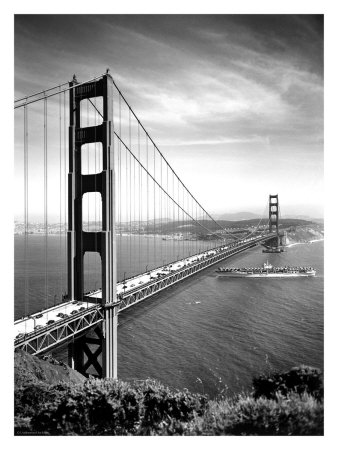 Literature and Art Literature and Art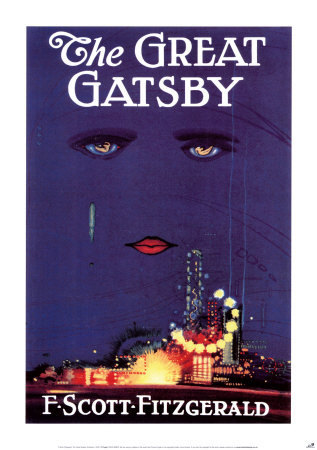 - Height of the Art Deco movement in North America and Western Europe.
Notable poetry include W. H. Auden's Poems. - Notable literature includes F. Scott Fitzgerald's Tender Is the Night (1934), J.R.R. Tolkien's The Hobbit (1937), Aldous Huxley's Brave New World (1932), John Steinbeck's Grapes of Wrath (1939) and Of Mice and Men (1937), Ernest Hemingway's To Have and Have Not (1937), John Dos Passos's U.S.A trilogy, William Faulkner's As I Lay Dying (1930) and Absalom, Absalom! (1936), John O'Hara's Appointment in Samarra (1934) and Butterfield 8 (1935).
- Notable "hardboiled" crime fiction includes Raymond Chandler's The Big Sleep, James M. Cain's The Postman Always Rings Twice (1934).
- Notable plays include Thorton Wilder's Our Town (1938).
- Near the end of the decade, two of the world's most iconic superheroes and recognizable fictional characters were introduced in comic books; Superman first appeared in 1938, and Batman in 1939.
 - The pulp fiction magazines began to feature distinctive, gritty adventure heroes that combined elements of hard boiled detective fiction and the fantastic adventures of the earlier pulp novels. Two particularly noteworthy characters introduced were Doc Savage and The Shadow, who would later influence the creation of characters such as Superman and Batman.
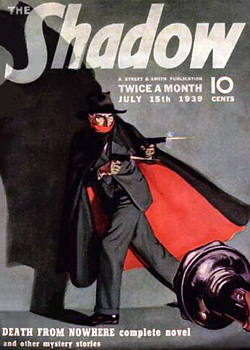
Written by Juniper Kedding.
5
« on: 03/09/2012 at 01:11 »
*****France 1935 - 1940***** France 1935 – 1940: President of France: Albert François Lebrun {Democratic Republican Alliance} from 1932 – 1940 before being succeeded by Philippe Pétain during Vichy France (When three fifths of France was under Axis jurisdiction) Though all conclusive decisions went through the President of France, The Prime minister (also known as Président du Conseil des Ministres aka President of the council of ministers) was charged with forming policies, decrees and acts in accordance with the administrative court. ((So basically president was the figure head and the prime minister did all the work ^^)) At the beginning of the 1930’s, a great depression hit France weakening its economy and sending the country into a recession. The government refused to devalue the franc until 1936 where unrest in the French population (particularly in the 1934 riots), coupled with overwhelming debts, saw a government change to combat the problem. Though the recession was mild and didn’t invoke a bank crisis, spending within the country decreased with living costs increasing. This affected a small minority of the population (mainly working class families) though crippled the French economy until a slight increase in economic development shined through in 1938. 1935 Prime Ministers: Pierre-Étienne Flandin {Democratic Alliance} until 1st June 1935, succeeded by Fernand Bouisson {Republican-Socialist Party} for a whole 6 days before Pierre Laval {Independent (conservative)} took over on the 7th June.January 7: Pierre Laval (French Foreign Minister) signed the Franco-Italian Agreement with Italian Prime Minister Benito Mussolini in Rome in an act to receive Italian support should Germany invade. May 2: Franco-Soviet Treaty of Mutual Assistance was signed in Paris, another effort by Laval to ensure support for France should it fall prey to an unprovoked attack. June 15/16: British racing drivers Johnny Hindmarsh and Luis Fontés won the 13th 24 hour Le Mans race. July 4 – 28th: Belgian Romain Maes won the 29th Tour de France in 141 hours and 32 minutes, covering 4,338 km (2,696 mi). December 13: The Hoare – Laval pact was leaked by French newspapers. The pact itself saw British Foreign secretary Samuel Hoare and French Prime minister Pierre Laval wanting to end the conflict between Abyssinia (now Ethiopia) and Italy by dividing the country up and giving Italy economical influence in the southern part of the country. French Cinema: Les Beaux Jours, Carnival in Flanders, Princess Tam Tam and Toni all released. 1936Prime Minister: Pierre Laval {Independent (conservative)} until 24 January; Albert Sarraut {Radical Socialist Party} until 4 June; Léon Blum {French Section of the Workers' International (Popular Front)}. 25 March - Second London Naval Treaty is signed by the governments of France, the United Kingdom, and the United States of America. 26 April - Legislative Election held. 3 May - Legislative Election held, resulting in the election of the Popular Front. 26 May - A general strike is initiated in Le Havre. 7 June - Matignon Agreements are signed between the CGPF employers trade union confederation, the CGT trade union and the French state during a general strike initiated after the election of the Popular Front. 7 July - Tour de France begins. 2 August - Tour de France ends, won by Sylvère Maes of Belgium. French Cinema: Cesar, The Crime of Monsieur Lange, The Lower Depths, Mayerling and Parisian Life all released.1937Prime Minister: Léon Blum {French Section of the Workers' International (Popular Front)} until 22 June; Camille Chautemps {Radical Socialist Party
(Popular Front)} 1 May - General strike in Paris. 21 June - Coalition government of Léon Blum resigns. 30 June - Tour de France begins. 25 July - Tour de France ends, won by Roger Lapébie. French Cinema: Arsene Lupin, Detective, Bizarre, Bizarre, Grand Illusion, Gribouille, Pépé le Moko and Yoshiwaraall released1938Prime Minister: Camille Chautemps {Radical Socialist Party (Popular Front)} until 13 March; Léon Blum {French Section of the Workers' International (Popular Front)} until 19 April; Édouard Daladier {Radical Socialist Party}. 10 April - Édouard Daladier becomes prime minister of France. 30 September - Munich Agreement is signed by Germany, France, Britain, and Italy permitting German annexation of Czechoslovakia's Sudetenland. 4 June - 1938 FIFA World Cup begins, hosted by France. 19 June - World Cup ends, won by Italy. 5 July - Tour de France begins. 31 July - Tour de France ends, won by Gino Bartali of Italy. 13 May - Charles Édouard Guillaume, physicist, awarded Nobel Prize in Physics in 1920 (born 1861). French Cinema: Adrienne Lecouvreur, The Baker's Wife, La Bête humaine, Gibraltar, Hôtel du Nord, J'accuse!, Mollenard, Port of Shadows all released.
1939 Prime Minister: Édouard Daladier {Radical Socialist Party}27 February - United Kingdom and France recognize Franco's government in Spain. 17 June - Last public guillotining in France - murderer Eugen Weidmann. 3 September - United Kingdom, France, New Zealand and Australia declare war on Germany. 10 July - Tour de France begins. 30 July - Tour de France ends, won by Sylvère Maes of Belgium. French Cinema: Berlingot and Company, Le Dernier Tournant, Le Jour se lève, The Rules of the Game, La Loi du nord and Louise all released. 1940Prime Minister: Édouard Daladier {Radical Socialist Party} until 21 March; Paul Reynaud {Democratic Alliance} until 16 June; Philippe Pétain {Military} 21 March - Édouard Daladier resigns as Prime Minister. French cabinet shuffles and Daladier is replaced by Paul Reynaud. 10 May - Battle of France begins - German forces invade Low Countries. 13 May - German armies open 60-mile wide breach in Maginot Line at Sedan. 18 May - Marshal Philippe Pétain named vice-premier of France. 19 May - General Maxime Weygand replaces Maurice Gamelin as commander-in-chief of all French forces. 20 May - German forces, under General Erwin Rommel, reach the English Channel. 26 May - Dunkirk evacuation of British Expeditionary Force starts. 3 June - Paris is bombed by the Luftwaffe for the first time. 4 June - Dunkirk evacuation ends - British forces complete evacuating 300,000 troops. 10 June - Italy declares war on France and the United Kingdom. 10 June - French government flees to Tours. 12 June - 13,000 British and French troops surrender to Field Marshal Erwin Rommel at St. Valery-en-Caux. 13 June - Paris is declared an open city. 14 June - French government flees to Bordeaux. 14 June - Paris falls under German occupation and German troops march past the Arc de Triomphe, following exactly the same route that the victorious French troops coming home from the First World war, 22 years previously. 15 June - Verdun falls to German forces. 17 June - Philippe Pétain becomes Prime Minister of France and immediately asks Germany for peace terms. 17 June - Operation Ariel begins - Allied troops start to evacuate France, following Germany's takeover of Paris and most of the nation. 17 June - Luftwaffe Junkers 88 bomber sinks British ship RMS Lancastria, that was evacuating troops from near Saint-Nazaire, France. Death toll is over 2500. Wartime censorship prevents the story going public. 18 June - General Charles de Gaulle broadcasts from London, calling on all French people to continue the fight against Nazi Germany: "France has lost a battle. But France has not lost the war." 21 June - Vichy France and Germany sign armistice at Compiègne in the same wagon-lit railroad car used by Marshal Ferdinand Foch to accept the surrender of Germany in 1918. 23 June - Adolf Hitler surveys newly defeated Paris. 24 June - Vichy France signs armistice terms with Italy. 28 June - General Charles de Gaulle is officially recognized by Britain as "Leader of all Free Frenchmen, wherever they may be." 3 July - British naval units sink or seize ships of the French fleet anchored in the Algerian ports of Oran and Mers El Kébir. 4 July - Vichy France breaks off diplomatic relations with Britain. 10 July - Vichy France begins with a constitutional law where only 80 members of the parliament voted against. 12 September - Lascaux: 17,000-year-old cave paintings are discovered by a group of young Frenchmen hiking through Southern France. The paintings depict animals and date to the Stone Age. References:
http://en.wikipedia.org/wiki/List_of_Prime_Ministers_of_France#President_of_the_Government_of_National_Defense
Beaudry, P,. and Portier, F. (2002) The French Depression in the 1930s. Review of Economic Dynamics, (5) 73–99. or alternatively… http://fpj.portier.free.fr/pub/French%20Depression.pdf
Lebesque, Morvan (1960), Chroniques du Canard, Éditions J-J Pauvert
Written by Filius Pendragon.
6
« on: 03/09/2012 at 01:06 »
1930-40s Muggle Technology
Radio In the thirties, radio was a staple. In the USA, 28 million households had a radio by 1939; in Britain, half of all households had a radio by 1933. In essence, radio was the ‘TV’ of the 1930s; soap operas, comedy shows, serials, advertisements, and news reports were all broadcasted through this medium. 1930s America, in particular, often focused broadcasts on entertainment instead of disheartening current events. In the forties, the radio would become an important means of communicating war news. Moving Pictures— Cinema In the late twenties, movie theaters became popular in both the USA and Europe. They were especially popular with Americans, who experienced the hardest turn of the economic slump, and in summertime, where the movie theaters’ air conditioning was a major attraction. In cinemas, most films screened were in black and white, and there was no ‘surround sound’; however, many modern comforts, such as comfortable seating, were available. Accompanying the featured films were theater newsreels, which functioned in much the same way as radio did by providing commercials, cartoons, and information on current affairs. — TelevisionIn the thirties, televisions were not as popular or common as radios were. By 1939 there were only a few operational TV stations and very few viewers, all in a select few (typically capital) cities. In the early forties, broadcasting television was formally introduced to the public at the 1939 World Fair; however, World War II slowed its development. Following World War II, television began to replace radio as the main medium.  1930s American cinema.Electricity 1930s American cinema.Electricity In the twenties and thirties, household electricity became common in cities and suburbs. Rural areas, however, did not tend to have electricity, and their residents continued to use kerosene lamps and coal, etc. Air ConditioningBy the thirties, air conditioning was available in public buildings such as cinemas. However, it was not common elsewhere, and the average person did not have it at home until much later, in the 1950s. Central HeatingIn the thirties and forties, only the upper class had modern central heating, while the average person used paraffin, oil, coal, etc. at home. Telephones Telephones in the thirties and forties used rotary dials. Phone numbers had seven numbers and did not have area codes; instead, they used exchange name formatting. Basically, this amounted to the first two or three letters of an area’s name being used as part of the phone number. In the US, a phone number was the first two letters of the area name plus five numbers; in Europe, a phone number was the first three letters plus four numbers. American example: ENglewood 3-1234 European example: WHItehall 1212  Transport — Cars Transport — Cars By the thirties, cars had become popular, but with the widespread economic troubles it was mostly more affluent people who could really afford keeping them.  — Trains — Trains Cheap and reliable, trains were the main method of transport for most people. — Planes Planes were not usually used for transport; when they were, it was typically by wealthier people on business. — Ships, &tc.Used by people from all economic backgrounds, ships and other maritime vehicles continued to be a reliable means of long-distance transport during the thirties and forties. Kitchen — Ovens Most people owned ovens that ran on gas, while only a few had electrically powered ovens. — Refrigerators Refrigerators became more common in the thirties, replacing iceboxes. However, a single unit refrigerator very closely-related to the modern fridge was available, with the cooling device located at the top of the cabinet, for high prices.  1934 GE monitor-top refrigerator.— Laundry Machines 1934 GE monitor-top refrigerator.— Laundry MachinesLaundry machines became widely available in the twenties. — Other AppliancesMany other basic electrical conveniences, such as toasters, were also now available at this time.
Additional Video Resources:Early 1930s Radio - Explained here. 1930s Electricity Infomercial here. Rotary Phone in Operation here.
Written by Aries Applesnow.
7
« on: 03/09/2012 at 01:01 »
Fashion: Before and During WWII In the years leading up to the war, fashion still came from the couture houses in Paris. The wealthy established the styles and it trickled down to the other classes. Fashion was inspired by Surrealists. Elsa Schiaparalli’s fantastic designs were the height of fashion. Hem lengths for women were below the knee. Men’s suits had long jackets, big lapels, big shoulders, and were often double breasted. There was also some slight waist definition in the jacket. Pants were straight leg, long and had a much higher waist. They wore fedoras, and men started to go shirtless in their swimsuits. Once the war began couture houses were forced close down after a shortage of materials and the fleeing of their clients. The United States was cut off from Parisian Fashion. As a result many American designers became popular. Fashion changed from over the top to something more simple and practical. With restrictions on fabric women’s skirts became straighter. Women were also more active and so skirt were also shortened to the knee. Flared and pleated pants, dresses, and skirts were forbidden because of the amount of fabric they used. So were double breasted sport coats for men. Clothes became more utilitarian and tailored. The world was focused on those engaged in combat and so clothes reflected the styles of military uniforms. Shoulders were padded and the waist was more defined with a belt. American designers focused on making things more functional as well as attractive. Clothes has large pockets and shoulder bags became popular. There was no restriction on material used in making hats. Turbans became more popular since they saved time on making an elaborate hairstyle. And with their simple dress, women went all out with their hats. Stockings were in high demand but the materials to make them were also needed in the war effort. As a result women would either wear cotton socks or paint their legs with make up. Women were encouraged to mend their clothes and to be resourceful. For example, they were encouraged to use curtains to make dresses and couch cushions to make jackets. People used color and accessories to create more decorative looks. Prints also became more popular since beads and sequins were hard to come by. Since there are so many different military uniforms please use this video to get an idea of how they looked. WWII Uniforms.The Women 1939, segment from the fashion show clip ((I think this is a great example, however the song I'm unsure about. Unfortunately I can not find the original scene. Fashion Before the War 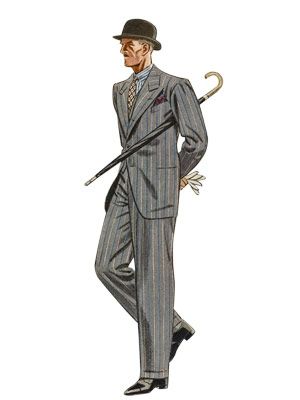 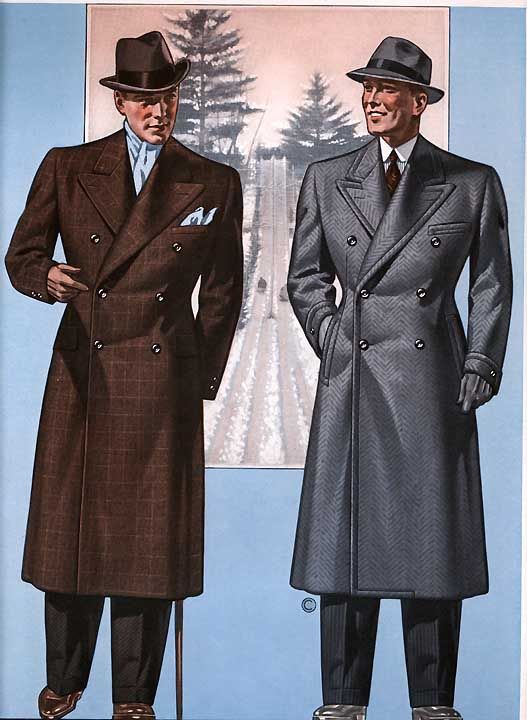  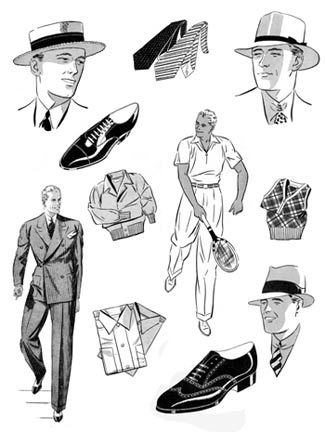 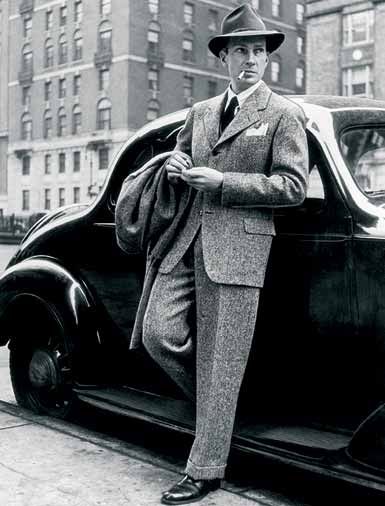 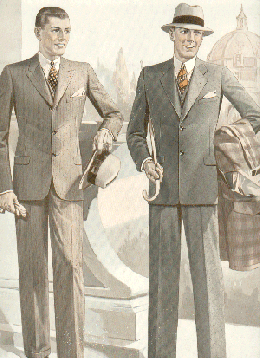   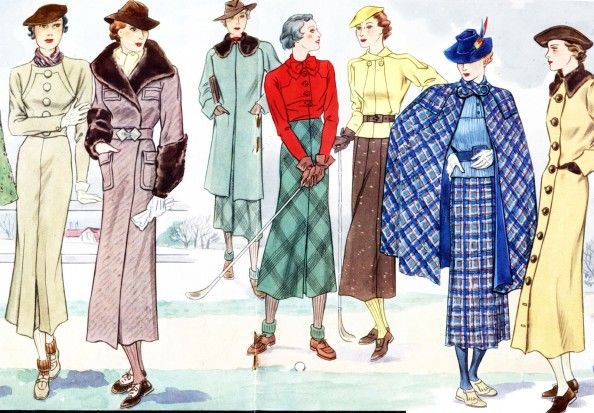 Fashion and Surrealism 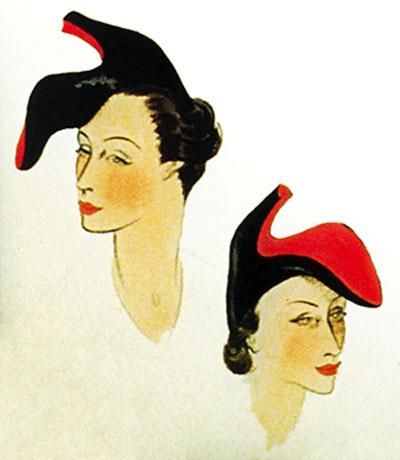 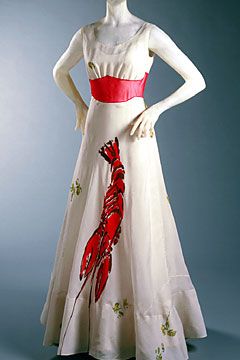  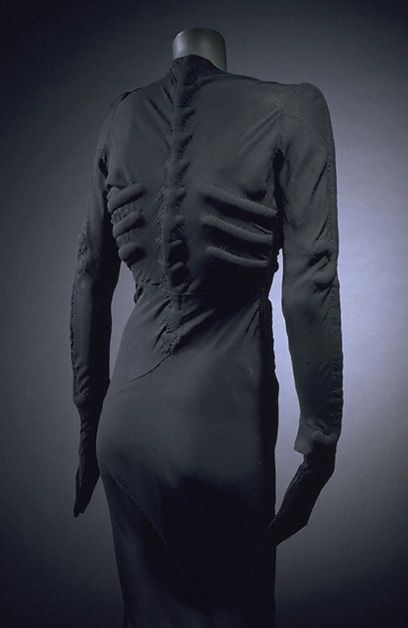 Women in Uniform 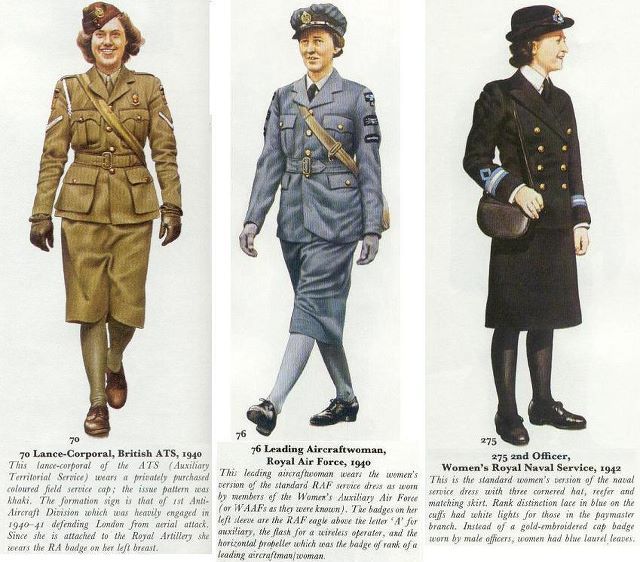  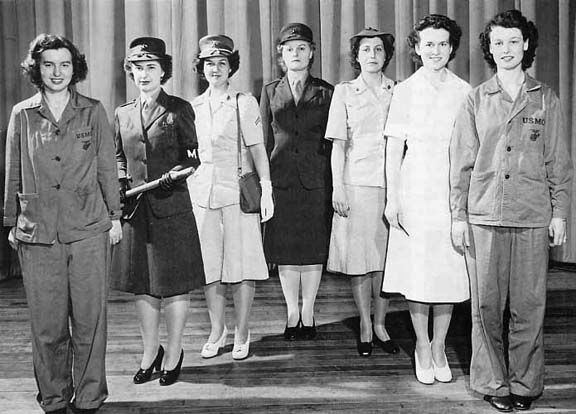 Fashion During Wartime 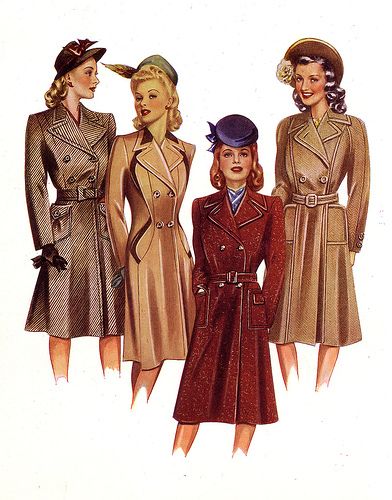 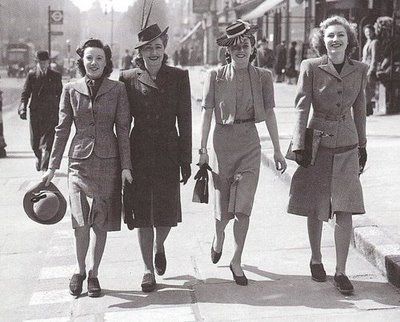 The Popover Dress 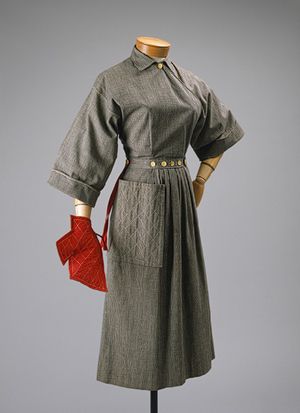 Makeup Stockings 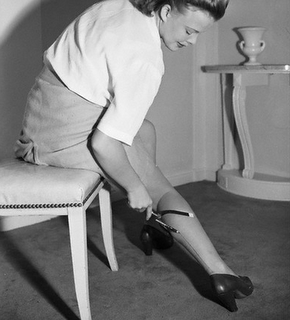 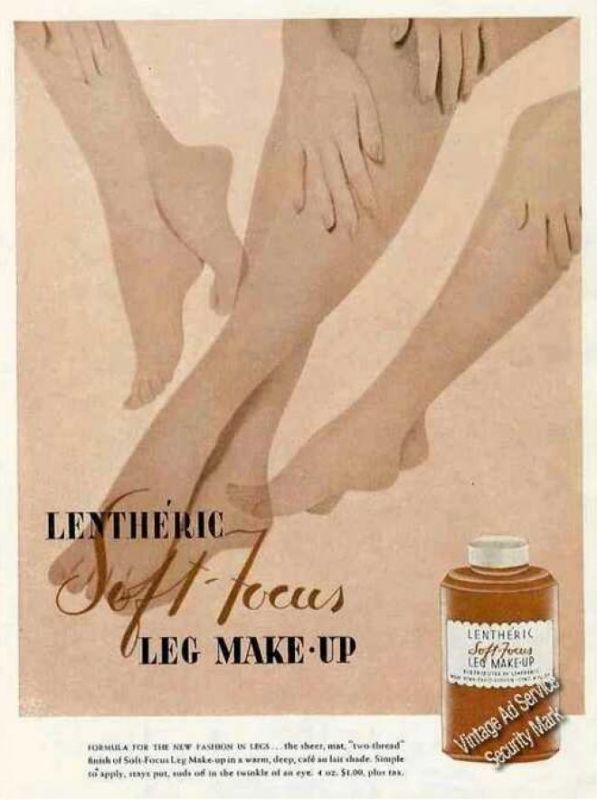 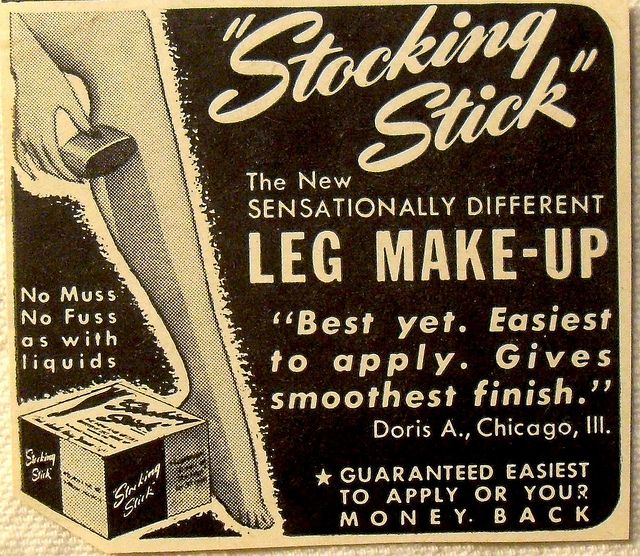 Hats  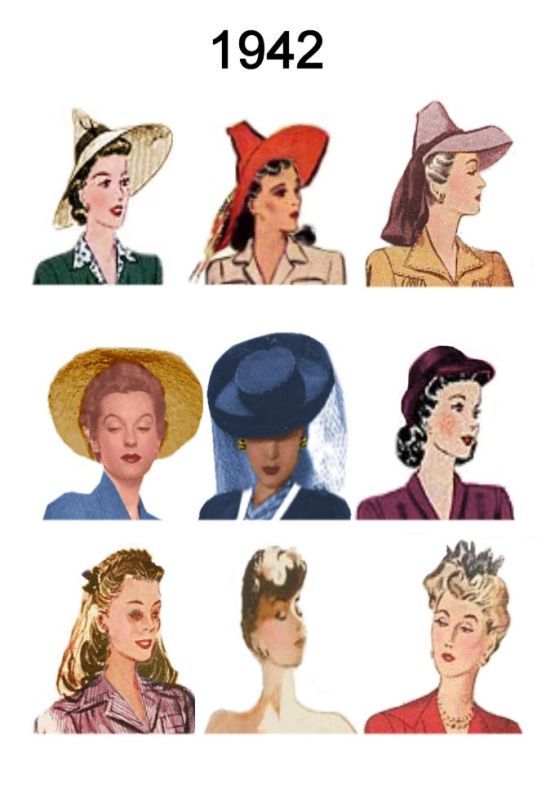 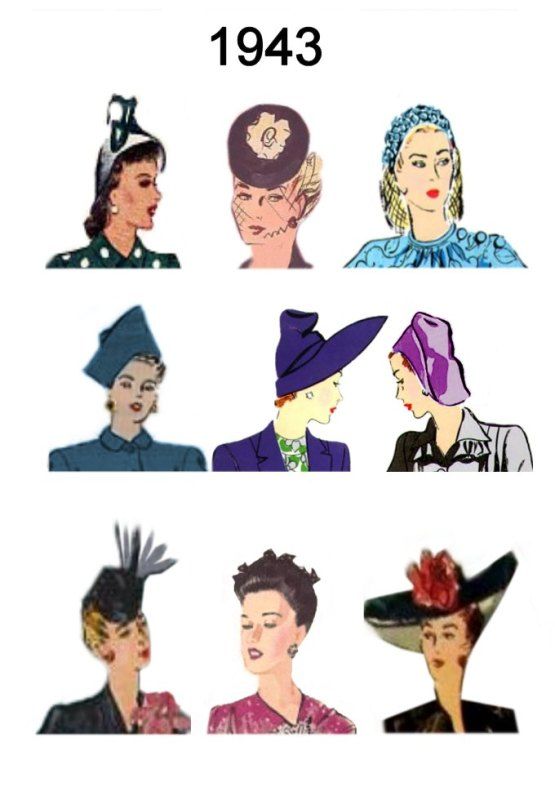
Written by Aymsley Trosset.
8
« on: 03/09/2012 at 00:56 »
References: http://www.bbc.co.uk/history/british/timeline/worldwars_timeline_noflash.shtmlhttp://en.wikipedia.org/wiki/Timeline_of_British_history_(1930%E2%80%931949) http://www.tes.co.uk/teaching-resource/Britain-since-the-1930s-Display-Timeline-and-resources-3001281/http://history1900s.about.com/od/timelines/tp/1930timeline.htm 1935 Prime Minister: Ramsay McDonald (till 7 June) [Labour], Stanley Baldwin (from 7 June) [Conservative]
World Events: Amelia Earhart flies solo from Hawaii to California. T.E. Lawrence dies. Germany issues anti-Jewish Nuremberg laws. Alcoholics Anonymous founded. Kit Kat introduced to Britain.18 March: Britain protests at Germany's introduction of conscription. 11 April: Italy, France and Britain meet to discuss German rearmament. 6 May: Silver Jubilee celebrations for King George V. 22 May: The government announces plans to triple the size of the Royal Air Force in the next two years. 7 June: Ramsay McDonald resigns due to ill health, Stanley Baldwin becomes PM. July: First Penguin paperbacks go on sale. 6 November: Maiden flight of the RAF's Hawker Hurricane fighter aircraft. Publications: Three Act Tragedy, Death in the Clouds, Regency Buck.1936Prime Minister: Stanley Baldwin [Conservative]
World Events: Olympics in Berlin. Hoover Dam completed. Spanish Civil War begins. Nazi Germany reoccupies the Rhineland. FDR is reelected. The K6 red telephone box is introduced. 20 January: George V dies, succeeded by Edward VIII. 2 November: the BBC launches the world’s first regular television service. 30 November: Crystal Palace destroyed in a fire. 10 December: Edward VIII abdicates to marry Wallis Simpson. Publications: The A.B.C. Murders, Keep the Aspidistra Flying, The Oxford Book of Modern Verse.1937Prime Minister: Stanley Baldwin (till 28 May), Neville Chamberlain (from 28 May) [Conservative]
World Events: The Hindenberg Disaster. The Golden Gate Bridge opens. Amelia Earhart vanishes. Japan invades China. Batman begins. The nickel-brass twelve-sided threepence coin is first introduced. 12 May: George VI’s coronation takes place. 28 May: Baldwin retires, Chamberlain becomes PM. 29 December: Éamon De Valera draws up a new constitution for Ireland that makes it a republic in all but name. Publications: Death on the Nile, The Road to Wigan Pier, The Hobbit, The Intelligent Woman’s Guide to Socialism and Capitalism.1938Prime Minister: Neville Chamberlain [Conservative]
World Events: Broadcast of ‘The War Of The Worlds’. Annexation of Austria. Night of the Broken Glass. Italy win the 1938 World Cup. 12 February: 10,000 Jewish children between five and seventeen arrive in Britain: the ‘Kindertransport’. 20 February: Anthony Eden resigns as Foreign Secretary over the ‘appeasement’ of Italy. 27 September: RMS Queen Elizabeth is launched. 30 September: The Munich Conference – Chamberlain declares ‘peace for our time’. Publications: Brighton Rock, The Sword In The Stone, Rebecca.1939 Prime Minister: Neville Chamberlain [Conservative]
World Events: First commercial flight over the Atlantic. German-Soviet non-aggression pact signed. Helicopter invented. World War Two begins. The birth of nylon stockings.31 March: Britain guarantees territorial integrity of Poland. 27 April: Military Training Act introduces conscription; men aged 20 and 21 must undertake six months military training. 24 August: Emergency Powers (Defence) Act 1939 gives full authority to 'defence regulations'. Parliament recalled, Army reservists called up and Civil Defence workers placed on alert. 30 August: Evacuation of children from major UK cities begins. 1 September: Blackout imposed, army officially mobilized. 3 September: Britain declares war on Germany. 1 October: Call-Up Proclamation: All men aged 20–21 must register with the military authorities. 21 October: Registration of men aged 20-23 for National Service begins. Publications: My Uncle Silas, Mister Johnson, Murder is Easy.1940Prime Minister: Neville Chamberlain (till 10 May 1940), Winston Churchill (from 10 May 1940) [Conservative]
World Events: Leon Trotsky assassinated. Tom and Jerry make their debut. Katyn massacre. Germany invades Norway, Denmark, Netherlands, Belgium, Luxembourg, France.8 January: Food rationing introduced. 10 May: Winston Churchill becomes PM of coalition government after Chamberlain resigns. 14 May: Recruitment for the LDV (Home Guard) begins. 26 May: Allied troops evacuated from Dunkirk. 9 July: The Battle of Britain begins. 9 August: Birmingham Blitz. 24 August: First air raid on London. 7 September: The beginning of the Blitz: 57 consecutive nights of strategic bombing on London. 14 November: Coventry Blitz. 19 November: Heavy air raids in Central England. 24 November: Bristol Blitz. 22 December: Manchester Blitz. 29 December: Heavy bombing causes the Second Great Fire of London. Publications: One, Two, Buckle my Shoe, The power and the Glory, Guilty Men.
Written by Scott Cooper.
Pages: [1]
|












































